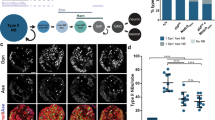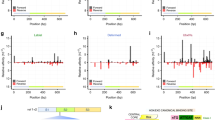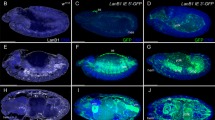Abstract
The transforming growth factor β (TGF-β) family member Decapentaplegic (Dpp) is a key regulator of patterning and growth in Drosophila development. Previous studies have identified a short DNA motif called the silencer element (SE), which recruits a trimeric Smad complex and the repressor Schnurri to downregulate target enhancers upon Dpp signaling. We have now isolated the minimal enhancer of the dad gene and discovered a short motif we termed the activating element (AE). The AE is similar to the SE and recruits the Smad proteins via a conserved mechanism. However, the AE and SE differ at important nucleotide positions. As a consequence, the AE does not recruit Schnurri but rather integrates repressive input by the default repressor Brinker and activating input by the Smad signal transducers Mothers against Dpp (Mad) and Medea via competitive DNA binding. The AE allows the identification of hitherto unknown direct Dpp targets and is functionally conserved in vertebrates.
This is a preview of subscription content, access via your institution
Access options
Subscribe to this journal
Receive 12 print issues and online access
$189.00 per year
only $15.75 per issue
Buy this article
- Purchase on Springer Link
- Instant access to full article PDF
Prices may be subject to local taxes which are calculated during checkout






Similar content being viewed by others
References
Derynck, R. & Miyazono, K. TGF-β and the TGF-β Family (Cold Spring Harbor Laboratory Press, Cold Spring Harbor, New York, USA, 2007).
Shi, Y. & Massague, J. Mechanisms of TGF-β signaling from cell membrane to the nucleus. Cell 113, 685–700 (2003).
Schmierer, B. & Hill, C.S. TGFβ-SMAD signal transduction: molecular specificity and functional flexibility. Nat. Rev. Genet. 8, 970–982 (2007).
Feng, X.H. & Derynck, R. Specificity and versatility in tgf-β signaling through Smads. Annu. Rev. Cell Dev. Biol. 21, 659–693 (2005).
Campbell, G. & Tomlinson, A. Transducing the Dpp morphogen gradient in the wing of Drosophila: regulation of Dpp targets by brinker. Cell 96, 553–562 (1999).
Jazwinska, A., Kirov, N., Wieschaus, E., Roth, S. & Rushlow, C. The Drosophila gene brinker reveals a novel mechanism of Dpp target gene regulation. Cell 96, 563–573 (1999).
Jazwinska, A., Rushlow, C. & Roth, S. The role of brinker in mediating the graded response to Dpp in early Drosophila embryos. Development 126, 3323–3334 (1999).
Minami, M., Kinoshita, N., Kamoshida, Y., Tanimoto, H. & Tabata, T. brinker is a target of Dpp in Drosophila that negatively regulates Dpp-dependent genes. Nature 398, 242–246 (1999).
Pyrowolakis, G., Hartmann, B., Muller, B., Basler, K. & Affolter, M. A simple molecular complex mediates widespread BMP-induced repression during Drosophila development. Dev. Cell 7, 229–240 (2004).
Gao, S., Steffen, J. & Laughon, A. Dpp-responsive silencers are bound by a trimeric Mad-Medea complex. J. Biol. Chem. 280, 36158–36164 (2005).
Pyrowolakis, G., Hartmann, B. & Affolter, M. TGF-β family signaling in Drosophila. in The TGF-β Family (eds. Derynck, R. & Miyazono, K.) 493–526 (Cold Spring Harbor Laboratory Press, Cold Spring Harbor, New York, USA, 2007).
Kim, J., Johnson, K., Chen, H.J., Carroll, S. & Laughon, A. Drosophila Mad binds to DNA and directly mediates activation of vestigial by decapentaplegic. Nature 388, 304–308 (1997).
Shi, Y. et al. Crystal structure of a Smad MH1 domain bound to DNA: insights on DNA binding in TGF-β signaling. Cell 94, 585–594 (1998).
Zawel, L. et al. Human Smad3 and Smad4 are sequence-specific transcription activators. Mol. Cell 1, 611–617 (1998).
Marty, T., Muller, B., Basler, K. & Affolter, M. Schnurri mediates Dpp-dependent repression of brinker transcription. Nat. Cell Biol. 2, 745–749 (2000).
Torres-Vazquez, J., Park, S., Warrior, R. & Arora, K. The transcription factor Schnurri plays a dual role in mediating Dpp signaling during embryogenesis. Development 128, 1657–1670 (2001).
Tsuneizumi, K. et al. Daughters against dpp modulates dpp organizing activity in Drosophila wing development. Nature 389, 627–631 (1997).
Sivasankaran, R., Vigano, M.A., Muller, B., Affolter, M. & Basler, K. Direct transcriptional control of the Dpp target omb by the DNA binding protein Brinker. EMBO J. 19, 6162–6172 (2000).
Xu, M., Kirov, N. & Rushlow, C. Peak levels of BMP in the Drosophila embryo control target genes by a feed-forward mechanism. Development 132, 1637–1647 (2005).
Barrio, R. & de Celis, J.F. Regulation of spalt expression in the Drosophila wing blade in response to the decapentaplegic signaling pathway. Proc. Natl. Acad. Sci. USA 101, 6021–6026 (2004).
Rushlow, C., Colosimo, P.F., Lin, M.C., Xu, M. & Kirov, N. Transcriptional regulation of the Drosophila gene zen by competing Smad and Brinker inputs. Genes Dev. 15, 340–351 (2001).
Zhang, H., Levine, M. & Ashe, H.L. Brinker is a sequence-specific transcriptional repressor in the Drosophila embryo. Genes Dev. 15, 261–266 (2001).
Kirkpatrick, H., Johnson, K. & Laughon, A. Repression of dpp targets by binding of brinker to mad sites. J. Biol. Chem. 276, 18216–18222 (2001).
Saller, E. & Bienz, M. Direct competition between Brinker and Drosophila Mad in Dpp target gene transcription. EMBO Rep. 2, 298–305 (2001).
Grieder, N.C., Marty, T., Ryoo, H.D., Mann, R.S. & Affolter, M. Synergistic activation of a Drosophila enhancer by HOM/EXD and DPP signaling. EMBO J. 16, 7402–7410 (1997).
Marty, T. et al. A HOX complex, a repressor element and a 50 bp sequence confer regional specificity to a DPP-responsive enhancer. Development 128, 2833–2845 (2001).
Rothe, M., Nauber, U. & Jackle, H. Three hormone receptor-like Drosophila genes encode an identical DNA-binding finger. EMBO J. 8, 3087–3094 (1989).
Chen, C.K. et al. The transcription factors KNIRPS and KNIRPS RELATED control cell migration and branch morphogenesis during Drosophila tracheal development. Development 125, 4959–4968 (1998).
Pankratz, M.J., Busch, M., Hoch, M., Seifert, E. & Jackle, H. Spatial control of the gap gene knirps in the Drosophila embryo by posterior morphogen system. Science 255, 986–989 (1992).
Karaulanov, E., Knochel, W. & Niehrs, C. Transcriptional regulation of BMP4 synexpression in transgenic Xenopus. EMBO J. 23, 844–856 (2004).
Yao, L.C. et al. Schnurri transcription factors from Drosophila and vertebrates can mediate Bmp signaling through a phylogenetically conserved mechanism. Development 133, 4025–4034 (2006).
Ross, S. & Hill, C.S. How the Smads regulate transcription. Int. J. Biochem. Cell Biol. 40, 383–408 (2008).
Yu, P.B. et al. Dorsomorphin inhibits BMP signals required for embryogenesis and iron metabolism. Nat. Chem. Biol. 4, 33–41 (2008).
Barolo, S. & Posakony, J.W. Three habits of highly effective signaling pathways: principles of transcriptional control by developmental cell signaling. Genes Dev. 16, 1167–1181 (2002).
Dai, H. et al. The zinc finger protein schnurri acts as a Smad partner in mediating the transcriptional response to decapentaplegic. Dev. Biol. 227, 373–387 (2000).
Gao, S. & Laughon, A. Flexible interaction of Drosophila Smad complexes with bipartite binding sites. Biochim. Biophys. Acta 1769, 484–496 (2007).
Korchynskyi, O. & ten Dijke, P. Identification and functional characterization of distinct critically important bone morphogenetic protein–specific response elements in the Id1 promoter. J. Biol. Chem. 277, 4883–4891 (2002).
Brodin, G., Ahgren, A., ten Dijke, P., Heldin, C.H. & Heuchel, R. Efficient TGF-β induction of the Smad7 gene requires cooperation between AP-1, Sp1 and Smad proteins on the mouse Smad7 promoter. J. Biol. Chem. 275, 29023–29030 (2000).
Denissova, N.G., Pouponnot, C., Long, J., He, D. & Liu, F. Transforming growth factor β–inducible independent binding of SMAD to the Smad7 promoter. Proc. Natl. Acad. Sci. USA 97, 6397–6402 (2000).
Nagarajan, R.P., Zhang, J., Li, W. & Chen, Y. Regulation of Smad7 promoter by direct association with Smad3 and Smad4. J. Biol. Chem. 274, 33412–33418 (1999).
von Gersdorff, G. et al. Smad3 and Smad4 mediate transcriptional activation of the human Smad7 promoter by transforming growth factor β. J. Biol. Chem. 275, 11320–11326 (2000).
Benchabane, H. & Wrana, J.L. GATA- and Smad1-dependent enhancers in the Smad7 gene differentially interpret bone morphogenetic protein concentrations. Mol. Cell. Biol. 23, 6646–6661 (2003).
Nellen, D., Burke, R., Struhl, G. & Basler, K. Direct and long-range action of a DPP morphogen gradient. Cell 85, 357–368 (1996).
Müller, B., Hartmann, B., Pyrowolakis, G., Affolter, M. & Basler, K. Conversion of an extracellular Dpp/BMP morphogen gradient into an inverse transcriptional gradient. Cell 113, 221–233 (2003).
Chen, D. & McKearin, D.M. A discrete transcriptional silencer in the bam gene determines asymmetric division of the Drosophila germline stem cell. Development 130, 1159–1170 (2003).
Kosman, D. et al. Multiplex detection of RNA expression in Drosophila embryos. Science 305, 846 (2004).
Markstein, M., Markstein, P., Markstein, V. & Levine, M.S. Genome-wide analysis of clustered Dorsal binding sites identifies putative target genes in the Drosophila embryo. Proc. Natl. Acad. Sci. USA 99, 763–768 (2002).
Ashburner, M. et al. Gene ontology: tool for the unification of biology. The Gene Ontology Consortium. Nat. Genet. 25, 25–29 (2000).
Kent, W.J. et al. The human genome browser at UCSC. Genome Res. 12, 996–1006 (2002).
Segalat, L., Berger, G. & Lepesant, J.A. Dissection of the Drosophila pourquoi-pas? promoter: complex ovarian expression is driven by distinct follicle cell- and germ line–specific enhancers. Mech. Dev. 47, 241–251 (1994).
Bischof, J., Maeda, R.K., Hediger, M., Karch, F. & Basler, K. An optimized transgenesis system for Drosophila using germ line–specific phiC31 integrases. Proc. Natl. Acad. Sci. USA 104, 3312–3317 (2007).
Brand, A.H. & Perrimon, N. Targeted gene expression as a means of altering cell fates and generating dominant phenotypes. Development 118, 401–415 (1993).
Cordier, F., Hartmann, B., Rogowski, M., Affolter, M. & Grzesiek, S. DNA recognition by the brinker repressor–an extreme case of coupling between binding and folding. J. Mol. Biol. 361, 659–672 (2006).
Ohshiro, T. & Saigo, K. Transcriptional regulation of breathless FGF receptor gene by binding of TRACHEALESS/dARNT heterodimers to three central midline elements in Drosophila developing trachea. Development 124, 3975–3986 (1997).
Nikaido, M., Tada, M., Takeda, H., Kuroiwa, A. & Ueno, N. In vivo analysis using variants of zebrafish BMPR-IA: range of action and involvement of BMP in ectoderm patterning. Development 126, 181–190 (1999).
Acknowledgements
We are deeply thankful to B. Hartmann (University of Freiburg) for generously providing the flies transgenic for UAS-ShnVP16. Work in the lab of M.A. was supported by the Kantons Basel-Stadt and Basel-Land, by the Swiss National Science Foundation and by SystemsX.ch within the framework of the wingX RTD. Work in G.P.'s laboratory was supported by the German Research Foundation (SFB592) and the Excellence Initiative of the German Federal and State Governments (EXC294).
Author information
Authors and Affiliations
Contributions
A.W., E.C., E.E. and C.W. performed the experiments; A.T. and A.W. generated the bioinformatic data; A.W. and M.A. wrote the manuscript; M.A., G.P. and R.S. contributed to design and interpretation of the experiments and payed the bills.
Corresponding authors
Supplementary information
Supplementary Text and Figures
Supplementary Figures 1–7 and Supplementary Table 1 (PDF 1744 kb)
Supplementary Table 2
List of conserved AEs. (XLS 260 kb)
Rights and permissions
About this article
Cite this article
Weiss, A., Charbonnier, E., Ellertsdóttir, E. et al. A conserved activation element in BMP signaling during Drosophila development. Nat Struct Mol Biol 17, 69–76 (2010). https://doi.org/10.1038/nsmb.1715
Received:
Accepted:
Published:
Issue Date:
DOI: https://doi.org/10.1038/nsmb.1715
This article is cited by
-
A role for Flower and cell death in controlling morphogen gradient scaling
Nature Cell Biology (2022)
-
Cis-regulatory chromatin loops arise before TADs and gene activation, and are independent of cell fate during early Drosophila development
Nature Genetics (2021)
-
Smad4 controls signaling robustness and morphogenesis by differentially contributing to the Nodal and BMP pathways
Nature Communications (2021)
-
Drosophila ML-DmD17-c3 cells respond robustly to Dpp and exhibit complex transcriptional feedback on BMP signaling components
BMC Developmental Biology (2019)
-
The morphogen Decapentaplegic employs a two-tier mechanism to activate target retinal determining genes during ectopic eye formation in Drosophila
Scientific Reports (2016)



